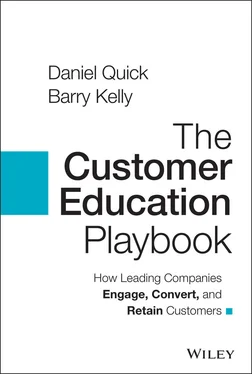We know many customer education professionals who are reluctant to charge for customer education, often citing that they don't want a price tag to be a “barrier” to learning content consumption. However, the barrier to content consumption is more often related to a lack of consumption strategies than it is to whether training content has been monetized. There are many programs that have customers who gladly pay for valuable training content! In fact, benchmark data suggests that the split between fee-based and free content is about 75 percent paid to 25 percent free. Sure, no one is going to start charging for support articles or marketing content – that's included as part of the 25 percent. However, when you think about that 75 percent, whether it's going to help the customer get better at their job, provide a certification for their resume, give them some kind of digital badge for their LinkedIn, or open their eyes to industry best practices – that's worth a price tag.
Don't be worried that charging for content will turn the customer off from engaging. When people pay for content, they are often intrinsically more motivated to see training through than they would be if the content was provided for free. The cost of the education is a signal to the market that says, “Hey! This training has value, it's going to help you in your career – it's worth your time.” Most users are comfortable with the idea that these benefits come with a price tag and may even see the training as more desirable because of the cost.
A smart monetization strategy will help you decide what content should be part of your free 25 percent and what should go in the other 75 percent. You may want to offer free training at the start of the customer journey – for example, in the form of webinars, user guides, or even a digital learning platform. As your users move through their lifecycle with you, you can then offer paid opportunities like eLearning, instructor-led training, or larger-scale certifications. You might create “premium” content focused on specific use cases or domain expertise. Many customers would gladly pay for training that is tailored to the specific way they want to use your product. Map out an ideal customer journey that takes your users through both free and paid content, and think about the ratio that works for you.
The formative decisions around scope and strategy that we've discussed in this chapter are essential points to consider, and will be the foundation of your customer education, playing a large role in proving your value overall. Now, with that in mind, let's turn to the 12 steps of the Customer Education Playbook itself and see how you can develop a clear and structured approach that leads to impactful, engaging, and measurable programs. Let's dive in!
1 1 Maria Manning-Chapman, “Fee and Free, Strategies and Considerations for Monetizing Customer Training,” Webinar, August 2021, https://www.tsia.com/webinars/free-and-fee-strategies-and-considerations-for-monetizing-customer-training.
3 Step 1: Maximize Impact by Aligning Customer Education to Business Goals
Customer education is a challenge, and the stakes are high. Without identifying your goals from the outset, you risk executing aimlessly, and you'll struggle to help others understand the impact of your work.
So, consider this: What do you want to get out of your customer education program?
This question is less about your customer education team itself and more about looking to the rest of the organization for guidance. Customer education teams don't work in a silo; they interact with many different functions of the business to help solve a wide range of challenges. To achieve success, the goals of customer education need to align with the overarching objectives of the company. In fact, the success of your customer education program hinges on executive support and buy-in, which can only happen if you make sure that you share a vision. If your goals aren't aligned, you'll end up doing a lot of work that isn't relevant for what the business is doing right now, and you're not going to get the executive support that you need to keep scaling and growing your program.
Five Common Business Goals for Customer Education
In this chapter, we'll cover five common business objectives and how you can align your own customer education goals to them to achieve success. For each example, we'll also identify the metrics you can use to measure your program and tangibly prove to the C-suite that the customer education program has a clear return on investment (ROI) in areas like generating direct revenue, reducing existing costs, or attracting new leads.
Goal 1: Improve Product Adoption
Product adoption challenges can come in many forms. Perhaps your business is releasing new features and customers aren't using them. Or maybe you have an onboarding issue, where customers who are new to your product are feeling overwhelmed or they aren't getting value during those critical first 90 days. It could even be that customers aren't adopting your product at all.
If product adoption is an organizational focus in your business, then your customer education program needs to ask, “How can customer education help to drive product adoption and fix the problem we're facing right now?” For example, if customers aren't adopting the product in the first place, you might want to create a prescriptive learning path for new customers that walks them through getting started. If the issue is that customers aren't trying out new features, you could launch content targeted specifically around those features. At Thought Industries, we create Feature Spotlight videos that focus on a single feature and the value it can provide to the user. As a direct result, I've seen huge growth in the adoption of empty state features, which previously had zero uptake before the content was created and released.
Of course, in some situations, adoption will be mandatory, such as a retail franchise that is onboarding a new point-of-sale product, such as a cash register. In this example, a product adoption challenge could be that users are making mistakes when they are first onboarded onto the solution – they're just not adopting it in the right way. A similar solution in this case would be to create a walkthrough or a tutorial for the first interaction for each new employee handling the machine to reduce or eliminate error.
Don't Talk about the Product!
It may seem counterintuitive, but an essential part of using customer education to boost product adoption is to remember that your customers and prospects don't care about your product! One of the most famous and often-quoted adages in marketing was coined by Theodore Levitt, who said, “People don't want to buy a quarter-inch drill, they want a quarter-inch hole. 1 It's outcomes that matter, not the product that facilitates that outcome.
Let's look at an example using a landing page builder app. If your training focuses on how to use the features of creating a landing page, such as how to enter a heading or add links, it doesn't deal with what users are really looking for. Rather than thinking about what the product does, think about the principles of landing page conversion and optimization. Your users want to generate sales, not just build a landing page. Education that focuses on how to build a page that's optimized for conversion, SEO, or best-practice design will be far more impactful.
Bottom line? Look to create customer education that talks about use cases and puts the value proposition as the star of the show rather than focus entirely on features and functionality. Your customers have hired your product to do a specific job, and what they really want to know is how it's going to help them make their lives easier.
Читать дальше












